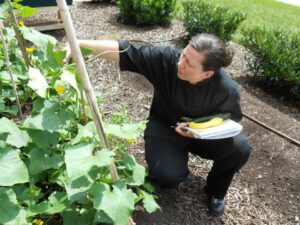Robin Mosley, Director of Communications & Strategic Engagement

Our new Executive Director, Kris Reid, explains her journey to the culinary industry and what her vision is for Slow Food USA.
Could you tell us about yourself? And how did you get your start in the culinary industry?
Well, I think that my start into the culinary industry is unique in that this is a second degree and second career for me. I started my life in accounting and quickly found out that I did not like to listen to the air conditioning and I did not like to move one pile of papers from one side of the desk to the other. But that gave me a really great a launching pad to excel very quickly.
When I was living in Los Angeles, I applied for Johnson and Wales while I was still working for a CPA firm and did not have the money to pay the tuition, I made too much money to get financial aid. So, I decided to move to Mexico for a year so that I could reapply for financial aid and be able to go to culinary school. While I ended up in Mexico, I met somebody who had a culinary school and invited me to attend and I ended up going to Calejo Gastronomico in Guadalajara while I was living there.
I was there for 6 months renewing my visa and unfortunately had a really serious accident down there but that was a sort of another sort of barrier and entering my culinary career. What I like to say is I broke my ass to become a chef, but that’s true. When I came back to the States, I applied for Johnson and Wales, and at that point I had not made the money disqualified me from the financial aid. And so, I moved to North Carolina, which is where I am now, and quickly became immersed into Slow Food culture.
Could you share your experience about leading both a business and nonprofit work? What inspired you to take on those dual roles as a chef and entrepreneur?
It’s funny because I’ve had a couple of different businesses since I left my full-time chef role. The desire was always to be available and of service to my community through Piedmont Culinary Guild. The motivation has always been to find positions that gave me the capacity both emotionally, financially and spiritually to be able to serve my community.
When you’re a chef, you have real ability to share messaging and people listen to you. I always say there’s a reason that a chef wears a white coat and so does a doctor. We’re touching people physically, spiritually, mentally and emotionally with food in the same way that medicine does, so chefs are really healers. Healing has always been the focus for my culinary endeavors and for-profit endeavors.
How were you first introduced to Slow Food and which aspects of the mission resonate most with your personal values?
You know, I’m a mom before I’m anything else, and I think becoming a mother was a big part of seeking out good, clean and fair food. As you’re nurturing your child, you want to give the best thing you can. I started growing food and making my own baby food. The mission of Slow Food matches my motherly mission, which is our defense begins at the table. That comes from the manifesto and that by eating the way that we do every single day we can have a huge impact on the world and we can really map out a future of food that we want to live in, especially for our children, which has been a lot of my motivation to do the work that I do, not just around the local food, but also around the community.
What message would you like to share with the Slow Food Network and its supporters. What’s the one thing you want them to take away.
I want them to take away that the work of Slow Food and the work that we’re doing together is making a significant difference and that by being together and we can achieve good, clean and fair food for all. If we’re using the framework for making decisions around food, we will create a sustainable food future for all of us.
As the Executive Director, what is your vision for Slow Food USA and what are your top priorities?
I don’t think it’s possible for us to have an organization without a network and we can’t have that network without a movement. My very first initiatives are going to be around what I call the 3 C’s, which is the continuity of operations of Slow Food USA leading a period of gentle health and evolution for the organization, chapter support and making sure that we’re supporting the network based on the manifesto, the theory of change and all the foundational principles of Slow Food. And the last C is connections. Making sure that we’re supporting the health and growth of our diverse elements within Slow Food and increasing these linkages and these elements of the food system to support good, clean and fair food for all.

